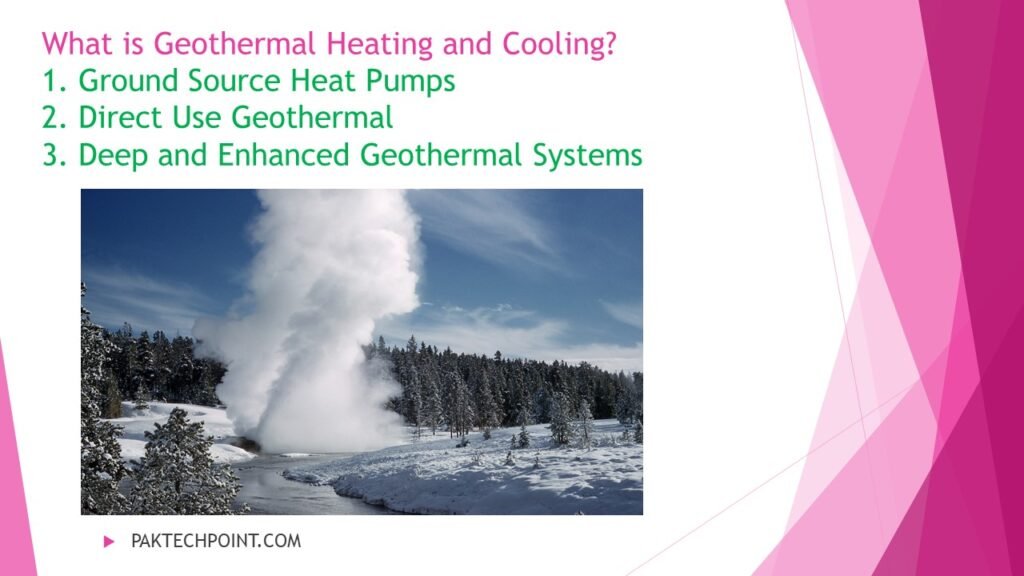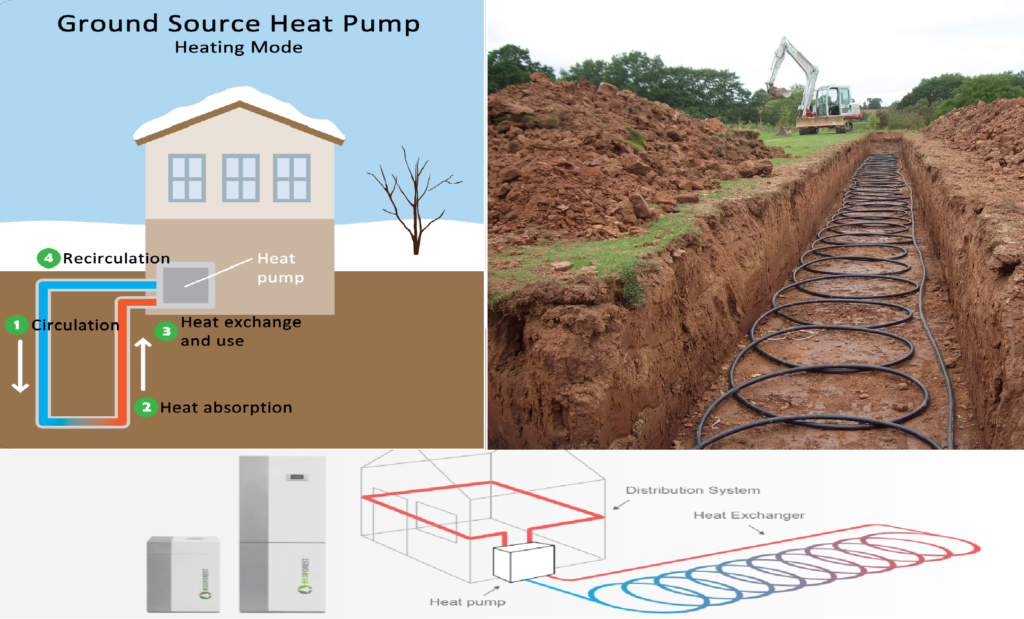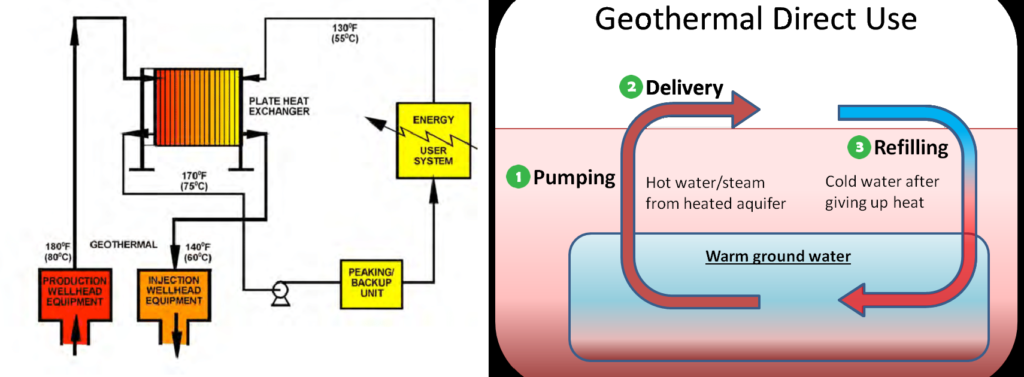Geothermal heating is a sustainable and energy-efficient heating system that utilizes the Earth’s natural heat to warm homes, buildings, and other spaces. It relies on the geothermal energy present beneath the Earth’s surface, which remains relatively constant throughout the year, regardless of external weather conditions.

Geothermal technology is a remarkable way of harnessing the Earth’s heat to provide sustainable and clean energy solutions. Just a few feet below the surface, the Earth maintains a relatively constant temperature, providing a stable heat source in contrast to the seasonal temperature variations above ground. As we dig deeper, the temperature increases at a consistent rate, making it a valuable resource for various applications.
There are three main types of geothermal technologies that take advantage of the Earth’s heat:
- Ground Source Heat Pumps: Ground source heat pumps utilize the Earth’s stable temperature to provide heating and cooling for buildings. These systems circulate a fluid through underground pipes (ground loops) to extract heat during the winter for heating and to dissipate heat during the summer for cooling. Ground source heat pumps are highly energy-efficient and can significantly reduce energy consumption for heating and cooling.
- Direct Use Geothermal: Direct use geothermal systems directly harness the Earth’s heat for practical purposes like heating buildings, greenhouses, or for industrial processes. The hot water or steam from geothermal reservoirs is pumped to the surface and distributed through a network of pipes to meet specific heating requirements. Direct use geothermal is cost-effective, reliable, and widely used in regions with suitable geothermal resources.
- Deep and Enhanced Geothermal Systems: Deep and enhanced geothermal technologies tap into higher temperature geothermal resources found at greater depths in the Earth’s crust. These systems are typically used to generate electricity by producing steam to drive turbines. In some cases, technologies like hydraulic fracturing (enhanced geothermal systems) are used to improve the permeability of hot rock formations, enabling efficient heat extraction.
Geothermal energy is considered a renewable resource because the Earth’s heat is continuously replenished by natural processes. Unlike fossil fuels, which are finite and non-renewable, geothermal energy offers a reliable and sustainable energy solution with minimal greenhouse gas emissions. It is a promising avenue for transitioning towards a greener and more sustainable energy future.
Ground Source Heat Pumps
Ground source heat pumps are highly efficient heating and cooling systems that capitalize on the temperature difference between the above-ground air and the subsurface soil. These systems are designed to provide space heating, space cooling (air conditioning), and even water heating for buildings. A ground source or geoexchange system typically consists of a heat pump connected to a network of buried pipes.
These buried pipes can be installed in two main configurations: horizontal trenches just below the ground surface or vertical boreholes that extend several hundred feet below ground. The heat pump circulates a heat-conveying fluid, often water, through these pipes to transfer heat between the building and the ground.
During colder months, if the ground temperature is warmer than the ambient air, the heat pump extracts heat from the ground and transfers it to the building for heating. In warmer months, the system can operate in reverse, moving heat from the indoor air to the ground, effectively cooling the building.
Ground source heat pumps require a small amount of electricity to power the heating and cooling process. However, for every unit of electricity consumed, the heat pump can deliver up to five times the energy from the ground, resulting in a net energy benefit. This high efficiency makes ground source heat pumps an environmentally-friendly and cost-effective choice for heating and cooling buildings.
It’s important to note that ground source heat pumps may not be completely fossil-fuel free if they rely on electricity generated from non-renewable sources. For users seeking a fully renewable-based system, it is essential to use electricity generated from renewable sources to power the heat pump’s operation, making the entire heating and cooling process truly sustainable and eco-friendly.

How Ground Source Heat Pumps Works?
Ground source heat pumps operate in both heating and cooling modes, making them versatile and efficient systems for providing comfort to buildings. The following steps describe how a heat pump works in each mode:
Heating Mode:
- Circulation: The above-ground heat pump circulates water or another fluid through a series of buried pipes or ground loops.
- Heat Absorption: As the fluid passes through the ground loop, it absorbs heat from the warmer soil, rock, or ground water surrounding it.
- Heat Exchange and Use: The heated fluid returns to the building and is utilized for space or water heating. A heat exchanger transfers the heat into the building’s existing air handling, distribution, and ventilation system. It can also be connected to a desuperheater for heating domestic water.
- Recirculation: Once the fluid transfers its heat to the building, it returns to the ground loop at a lower temperature to be heated again. This cyclic process repeats, efficiently moving heat from one location to another for the occupants’ comfort.
Cooling Mode:
- Heat Exchange and Absorption: Water or another fluid absorbs heat from the air inside the building through a heat exchanger, similar to how a conventional air conditioner works.
- Circulation: The above-ground heat pump moves the heated fluid through the buried pipes or ground loops.
- Heat Discharge: As the heated fluid passes through the ground loop, it releases heat to the relatively colder soil, rock, or ground water surrounding it.
- Recirculation: The fluid returns to the building at a lower temperature, ready to absorb heat from the indoor air again. This process repeats, efficiently moving heat from one location to another for cooling purposes.
The heat pump itself, located above ground, is relatively affordable, with the primary cost associated with the installation of the ground loops underground. Ground source heat pumps are suitable for space heating and cooling needs in various regions and can also be used for domestic hot water applications. By increasing the capacity of the piping loops, this technology can be scaled up for larger buildings or locations with substantial heating, cooling, and water heating requirements throughout the year.
Unlocking Earth’s Heat: Direct Use Geothermal Systems
Direct use geothermal systems harness naturally heated groundwater from below the Earth’s surface to provide a wide range of useful applications. These systems utilize hot water, which can reach temperatures as high as 200°F or more, found in areas with volcanic or tectonic activity. Locations like Yellowstone National Park and Iceland are well-known for their hot groundwater reservoirs, which create geysers and hot springs.
The process of direct use geothermal involves the following steps:
- Pumping: A well is drilled to tap into the hot groundwater. In some cases, hot water or steam may naturally rise up through the well without active pumping.
- Delivery: The hot water or steam can be used directly for various applications or cycled through a heat exchanger.
- Refilling: Depending on system requirements and site conditions, the ground water aquifer may need to be replenished with water from the surface. In some cases, the movement of ground water can naturally refill the aquifer.
Direct use geothermal systems have numerous applications, including large-scale pool heating, space heating, cooling, and on-demand hot water for buildings, district heating for multiple buildings in a city, heating roads and sidewalks for snow melting, and various industrial and agricultural processes. These systems take advantage of hot water located just a few feet below the surface, typically less than a mile deep. The shallow depth makes capital costs relatively low compared to deeper geothermal systems. However, this technology is limited to regions with natural sources of hot groundwater near or at the surface.

Harnessing Earth’s Heat: Deep and Enhanced Geothermal Systems
Deep geothermal systems tap into steam far below the Earth’s surface to provide high-temperature heat for various applications. These systems involve drilling wells that go a mile or more deep, where the pressure keeps water in a liquid state even at very high temperatures. The hot water or steam is then pumped up to the surface, where it can be used to heat a secondary fluid or used directly for industrial processes and electricity generation.
Unlike ground source heat pumps or direct use geothermal systems, which use relatively shallow hot water near the surface, deep geothermal sources provide extremely hot steam suitable for specialized purposes. While the initial capital costs for drilling can be high, the operational costs are low since geothermal steam requires no fuel.
Research is also underway to develop enhanced geothermal systems that can make use of the Earth’s natural temperature gradient and create subsurface reservoirs to enhance steam production. These enhanced systems have the potential to be constructed in many regions, unlocking more opportunities for sustainable and clean energy.
